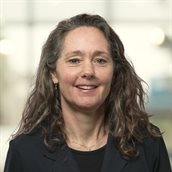Energy transition requires collaboration
The Space for Energy programme is needed now that the role of energy in society has changed significantly. One example is that energy infrastructure used to play a minor role when a new residential area or business park was designed. This was only logical in the old situation in the energy sector. Energy was generated in large power plants and transmitted through the grid.
The energy transition is significantly changing the landscape for a sustainable energy system. As a result, decisions regarding the energy system and energy infrastructure have a substantial impact on spatial planning and the energy network.
It is therefore crucial for energy engineers (including consultants, engineers, and energy project managers) and urban planners to seek collaboration, which they are not accustomed to doing. Through the "Space for Energy" program, we, at TNO Vector, aim to facilitate improvements in this regard.
Climate press conference by Rob Jetten
Rob Jetten, outgoing Minister for Climate and Energy Policy, held a climate press conference on 3 July 2023. Among other things, he discussed the spatial challenges posed by the energy transition and changes to the energy infrastructure.
Jetten indicated that the government is reserving physical space to manage the energy transition in the coming years. Renewable energy generation and storage require a lot of space, but this is limited in the Netherlands because nature, agriculture, house-building, and businesses also need room.
‘Bring the energy sector to the table earlier’
What are the specific areas of improvement at the centre of the Space for Energy programme? Nienke Maas, Senior Energy Transition Adviser at TNO Vector, explains: ‘The government has identified a number of regions that are to grow and become more urbanised in the future.
Building density must increase, functions will have to be combined, and mobility needs are rising. The subject of energy often comes up only when such plans are nearly ready. Rijkswaterstaat (the Directorate General for Public Works and Water Management) and the regional water board have been at the table from the outset. It would help enormously if representatives of the energy sector were involved at the same time.’
Nienke Maas continues: ‘It’s no surprise that the current situation is the way it is. In the past, there was no need to involve the energy sector in the design phase. At that time, we had large power plants in a limited number of places in the Netherlands. And we used gas from the Groningen field. As an urban planner, you didn’t have to think about the local energy system and its infrastructure.’
Towards a decentralised energy system
Now and in the future, we do need to involve the energy sector at an early stage. Maas says: ‘We’re working hard in the Netherlands to create a predominantly decentralised energy system. A system with energy from local sources and local storage.
Local energy infrastructure used to be a matter of underground cables and pipes. The new situation calls for space, which means the spatial design literally and figuratively gives space to energy. With the Space for Energy programme, we provide insight to energy engineers and urban planners. This lets them know what to take into account when it comes to energy.’
Tools and resources
TNO Vector can help public authorities, organisations, and market players make the changes needed. ‘We not only have substantive knowledge about energy systems in-house, but also understand how decision-making and policy work. With that knowledge, we can support all stakeholders,’ says Maas.
Practical issues are translated into tools that improve collaboration between urban planners and energy engineers. Examples include:
- Maps we can also use to perform calculations on the energy system.
- Process models focused on the decision-making process.
Maas adds: ‘We continue to develop the tools and test them in practice, during projects we’re involved in. Learning by doing, in other words.’
Complexity of spatial planning
TNO Vector is already in talks with several locations and involved in various projects, for example in Venlo, Groningen, and Bergen op Zoom.
‘We find that the issue is very much alive,’ says Maas. ‘Public authorities want to be better prepared and proactive in dealing with demands for space from the energy system, instead of just letting things happen to them. And sometimes, we’re also told that spatial planning is very complicated in itself, without including energy infrastructure as a component. The Space for Energy programme should reduce complexity.’
Operational and strategic level
It is important to distinguish between the operational and strategic levels. The challenge of combining space and energy in policy is present at both levels.
At the operational level, it concerns the square or cubic metres occupied by wind turbines and electrolysers, for example. At the strategic level, it concerns spatial and economic development.
Issues at the strategic level include:
- Where do you expand residential areas or business parks, with a view to generating and storing renewable energy and connecting to the grid?
- Which functions do you prefer to plan close together?
Cultures come together
One of the objectives of the Space for Energy programme is better collaboration between two professions. Maas explains: ‘It’s also about different work cultures.
That’s why we also look at it from a human perspective. What kind of language do the various parties speak? What does that mean for collaboration between policymakers and the energy sector? And how can we build bridges where needed?
By also considering matters from this point of view, we learn what information stakeholders need and how best to start the conversation. This will ultimately reduce frustration and energy will be considered earlier in spatial design.’
Space for Energy programme offers prospects
The ambition of the Space for Energy programme goes beyond simply putting the issue on the agenda. The programme, launched by the Top Sector Energy, offers prospects to parties involved in the energy transition.
In the programme, TNO Vector combines technological and engineering know-how with knowledge of policy and decision-making. We enjoy working with parties involved in spatial development and/or energy systems.
Maas concludes: ‘The Ministry of Economic Affairs and Climate Policy also sees the importance of the connection between region, space, and energy, and they recognise that energy will play a structural role within the region.’
Want to know more about the Space for Energy programme? Or join us in thinking about spatial design and the future energy system? If so, don’t hesitate to contact us.




